Mid-Norfolk Railway: Difference between revisions
No edit summary |
|||
| (One intermediate revision by the same user not shown) | |||
| Line 10: | Line 10: | ||
|length=17½ miles (14 miles operational) | |length=17½ miles (14 miles operational) | ||
}} | }} | ||
The '''Mid-Norfolk Railway | The '''Mid-Norfolk Railway''' is a heritage railway in [[Norfolk]]. Re-opening as a tourist line in the mid-1990s, it is often referred to as a "New Generation" heritage railway, especially since the start of preservation in 1974. | ||
The fourteen-mile line runs through the centre of Norfolk between the market towns of [[Wymondham]] and [[East Dereham]] via Yaxham, Thuxton and Kimberley Park, operating steam and diesel services. The operational line extends northwards from [[East Dereham]] to [[Hoe]], although only infrequent sightseer services operate over this section as there is no station at the latter location.<ref>[http://www.railwaymagazine.co.uk/news/-mid-norfolk-runs-first-passenger-train-north-to-hoe Mid Norfolk runs first passenger train north to Hoe]</ref> The line is periodically used for commercial freight operations and staff instruction for mainline railway companies. | The fourteen-mile line runs through the centre of Norfolk between the market towns of [[Wymondham]] and [[East Dereham]] via Yaxham, Thuxton and Kimberley Park, operating steam and diesel services. The operational line extends northwards from [[East Dereham]] to [[Hoe]], although only infrequent sightseer services operate over this section as there is no station at the latter location.<ref>[http://www.railwaymagazine.co.uk/news/-mid-norfolk-runs-first-passenger-train-north-to-hoe Mid Norfolk runs first passenger train north to Hoe]</ref> The line is periodically used for commercial freight operations and staff instruction for mainline railway companies. | ||
| Line 25: | Line 25: | ||
The Wymondham to Wells branch was opened in stages between 15 February 1847 and 1857,<ref name="reghist">{{cite book |last=Oppitz |first=Leslie |title=East Anglia Railways Remembered |date=Autumn 1989 |publisher=Countryside Books |isbn=1-85306-040-2 |page=41}}</ref> after Parliamentary consent was given in 1845.<ref>{{cite book |title=The Railways of the United Kingdom Statistically Considered |last=Scrivenor |first=Harry |year=1849 |publisher=Smith, Elder and Co. |page=334 |url=http://books.google.com/?id=6jmFq73U91gC&pg=PA341&lpg=PA341&dq=norfolk+railway+act+of+parliament}}</ref> The entire line became part of the Great Eastern Railway in 1862.<ref>[http://www.mnr.org.uk/about/history/ MNR history of the line]</ref> The line between Wymondham and Dereham was provided with double track in 1882,<ref name="jenkhist">{{cite book |last=Jenkins |first=S. |title=The Lynn and Dereham Railway |year=1993 |publisher=Oakwood Press |isbn=0-85361-443-1 |page=50}}</ref> and then part of the Southern Area of the London and North Eastern Railway at the Grouping in 1923.<ref name="jenkhist1">{{cite book |last=Jenkins |first=S. |title=The Lynn and Dereham Railway |year=1993 |publisher=Oakwood Press |isbn=0-85361-443-1 |page=69}}</ref> The line was heavily used during World War I and Second World War, with extra Air Ministry sidings provided at Dereham in 1943.<ref name="jenkhist3">{{cite book |last=Jenkins |first=S. |title=The Lynn and Dereham Railway |year=1993 |publisher=Oakwood Press |isbn=0-85361-443-1 |page=87}}</ref> In the early days of the war, Dereham was used as a reception centre for the construction materials used to build the local airfields. From nationalisation in 1948, the line was part of the Eastern Region of British Railways. | The Wymondham to Wells branch was opened in stages between 15 February 1847 and 1857,<ref name="reghist">{{cite book |last=Oppitz |first=Leslie |title=East Anglia Railways Remembered |date=Autumn 1989 |publisher=Countryside Books |isbn=1-85306-040-2 |page=41}}</ref> after Parliamentary consent was given in 1845.<ref>{{cite book |title=The Railways of the United Kingdom Statistically Considered |last=Scrivenor |first=Harry |year=1849 |publisher=Smith, Elder and Co. |page=334 |url=http://books.google.com/?id=6jmFq73U91gC&pg=PA341&lpg=PA341&dq=norfolk+railway+act+of+parliament}}</ref> The entire line became part of the Great Eastern Railway in 1862.<ref>[http://www.mnr.org.uk/about/history/ MNR history of the line]</ref> The line between Wymondham and Dereham was provided with double track in 1882,<ref name="jenkhist">{{cite book |last=Jenkins |first=S. |title=The Lynn and Dereham Railway |year=1993 |publisher=Oakwood Press |isbn=0-85361-443-1 |page=50}}</ref> and then part of the Southern Area of the London and North Eastern Railway at the Grouping in 1923.<ref name="jenkhist1">{{cite book |last=Jenkins |first=S. |title=The Lynn and Dereham Railway |year=1993 |publisher=Oakwood Press |isbn=0-85361-443-1 |page=69}}</ref> The line was heavily used during World War I and Second World War, with extra Air Ministry sidings provided at Dereham in 1943.<ref name="jenkhist3">{{cite book |last=Jenkins |first=S. |title=The Lynn and Dereham Railway |year=1993 |publisher=Oakwood Press |isbn=0-85361-443-1 |page=87}}</ref> In the early days of the war, Dereham was used as a reception centre for the construction materials used to build the local airfields. From nationalisation in 1948, the line was part of the Eastern Region of British Railways. | ||
The branch line between County School and [[Wroxham]] closed to passengers on 15 September 1952, with the section between [[Foulsham]] and [[Reepham]] closing to goods as well. A stub of the western section, between County School and Foulsham remained open for goods until 31 October 1964,<ref>British Railways Atlas.1947. p.18</ref> being busiest in the sugar beet season.<ref name="jobhist">{{cite book | The branch line between County School and [[Wroxham]] closed to passengers on 15 September 1952, with the section between [[Foulsham]] and [[Reepham, Norfolk|Reepham]] closing to goods as well. A stub of the western section, between County School and Foulsham remained open for goods until 31 October 1964,<ref>British Railways Atlas.1947. p.18</ref> being busiest in the sugar beet season.<ref name="jobhist">{{cite book | ||
|last=Joby |first=R.S. |title=The East Norfolk Railway |year=1975 |publisher=Klofron, Norwich |page=43}}</ref> | |last=Joby |first=R.S. |title=The East Norfolk Railway |year=1975 |publisher=Klofron, Norwich |page=43}}</ref> | ||
| Line 69: | Line 69: | ||
==Present day== | ==Present day== | ||
[[File:MNR double track at Wymondham.jpg|right|thumb|Bridge 1671, with visual effect of original | [[File:MNR double track at Wymondham.jpg|right|thumb|Bridge 1671, with visual effect of original double track restored, near Wymondham Abbey.]] | ||
[[File:9466 at Hoe.jpg|right|thumb| | [[File:9466 at Hoe.jpg|right|thumb|GWR 9400 Class No. 9466 at Hoe, 2009]] | ||
The 11½ mile section of line between Dereham and Wymondham is in regular use, with a further 2½ miles passed for operation, but only used for periodic charter and works trains. The Trust owns the further 3½ miles of disused railway to County School station near [[North Elmham]],<ref>{{cite web |url=http://www.derehamtimes.co.uk/content/derehamtimes/everything/EVE.pdf |title=From Jazz to Santa |accessdate=2009-07-20 |format=pdf |publisher=Dereham Times |quote=The Trust currently owns 17.5 miles of track and trackbed, just over 11 miles of which is currently in use connecting Dereham Station with Wymondham Abbey Station}}</ref> although there is a break of around a mile between North Elmham and County School where the track is no longer in situ. This makes the Mid-Norfolk Railway one of the longest standard-gauge heritage railways in the [[United Kingdom]]. The track bed is mostly intact from County School to [[Fakenham]], and is reserved by the council for railway use.<ref>{{cite web |url=http://www.norfolk.gov.uk/consumption/groups/public/documents/article/ncc037183.pdf |title=Safeguarding Transport Routes |accessdate=18 February 2009 |format=pdf |publisher=Norfolk County Council |pages=9}}</ref> Although it is not yet in the Trust's ownership, the railway plans restoration of the line to this third market town. | The 11½ mile section of line between Dereham and Wymondham is in regular use, with a further 2½ miles passed for operation, but only used for periodic charter and works trains. The Trust owns the further 3½ miles of disused railway to County School station near [[North Elmham]],<ref>{{cite web |url=http://www.derehamtimes.co.uk/content/derehamtimes/everything/EVE.pdf |title=From Jazz to Santa |accessdate=2009-07-20 |format=pdf |publisher=Dereham Times |quote=The Trust currently owns 17.5 miles of track and trackbed, just over 11 miles of which is currently in use connecting Dereham Station with Wymondham Abbey Station}}</ref> although there is a break of around a mile between North Elmham and County School where the track is no longer in situ. This makes the Mid-Norfolk Railway one of the longest standard-gauge heritage railways in the [[United Kingdom]]. The track bed is mostly intact from County School to [[Fakenham]], and is reserved by the council for railway use.<ref>{{cite web |url=http://www.norfolk.gov.uk/consumption/groups/public/documents/article/ncc037183.pdf |title=Safeguarding Transport Routes |accessdate=18 February 2009 |format=pdf |publisher=Norfolk County Council |pages=9}}</ref> Although it is not yet in the Trust's ownership, the railway plans restoration of the line to this third market town. | ||
Latest revision as of 12:35, 18 November 2018
The Mid-Norfolk Railway is a heritage railway in Norfolk. Re-opening as a tourist line in the mid-1990s, it is often referred to as a "New Generation" heritage railway, especially since the start of preservation in 1974.
The fourteen-mile line runs through the centre of Norfolk between the market towns of Wymondham and East Dereham via Yaxham, Thuxton and Kimberley Park, operating steam and diesel services. The operational line extends northwards from East Dereham to Hoe, although only infrequent sightseer services operate over this section as there is no station at the latter location.[1] The line is periodically used for commercial freight operations and staff instruction for mainline railway companies.
It is the southern section of the former Wymondham, Dereham, Fakenham and Wells-next-the-Sea line, opened by the Norfolk Railway in 1847 and closed to passengers in stages from 1964 to 1969 as part of the Beeching Axe. The final section of the line closed to goods traffic in 1989. The northern section of this line has been operated by the Wells and Walsingham Light Railway since 1982.
The Mid-Norfolk Railway is owned and operated by the Mid-Norfolk Railway Preservation Trust (a charitable trust), and is mostly operated and staffed by volunteers. The company owns a further 3½ miles of line, as far as County School railway station, which will make it the third longest heritage railway in England once restoration is complete. The Mid-Norfolk Railway has long-term ambition to restore the railway as far as Fakenham.
The line is the fifth longest preserved standard gauge railway in Great Britain.
History
Route history

The Wymondham to Wells branch was opened in stages between 15 February 1847 and 1857,[2] after Parliamentary consent was given in 1845.[3] The entire line became part of the Great Eastern Railway in 1862.[4] The line between Wymondham and Dereham was provided with double track in 1882,[5] and then part of the Southern Area of the London and North Eastern Railway at the Grouping in 1923.[6] The line was heavily used during World War I and Second World War, with extra Air Ministry sidings provided at Dereham in 1943.[7] In the early days of the war, Dereham was used as a reception centre for the construction materials used to build the local airfields. From nationalisation in 1948, the line was part of the Eastern Region of British Railways.
The branch line between County School and Wroxham closed to passengers on 15 September 1952, with the section between Foulsham and Reepham closing to goods as well. A stub of the western section, between County School and Foulsham remained open for goods until 31 October 1964,[8] being busiest in the sugar beet season.[9]

The passenger service between Dereham and Wells ended on 5 October 1964.[10] Dereham became an intermediate station for Norwich to King's Lynn services. In June 1965, the Wymondham to Dereham section was reduced to single track with a passing loop at Hardingham. The passenger service from King's Lynn ended on 9 September 1968,[11] with the Midland & Great Northern Joint Railway Society operating the 'East Anglian Branch Line Farewell' DMU special on the final Saturday.[12] The withdrawal of the remaining passenger services, between Wymondham and Dereham, followed in October 1969.[13]
In 1977 the Wymondham, Dereham and Fakenham Railway Action Committee presented the Norfolk County Chief Planning Officer with a report putting the case for restoring rail passenger services between Norwich, Dereham and Fakenham East.[14] Complete closure of the line took place in June 1989.[15]
Preservation
Fakenham and Dereham Railway Society
In 1978 the Fakenham and Dereham Railway Society was founded, hoping to preserve the line between these two towns. In 1983, having failed to preserve the Ryburgh to Fakenham section of line, the Society leased Hardingham station and opened a small heritage centre. Track was laid in the former goods yard and a Ruston 0-4-0 diesel locomotive was delivered to the site. Income failed to cover the rent and rates, and the Society was forced to move out when the site was auctioned in 1986 - moving to a temporary location at Yaxham station.
In 1987 the station at County School was purchased by the council, who gave the F&DRS a 999-year lease, invited them to lay track and relocate to the site.[16]
Mid Norfolk Railway Society and Great Eastern Railway (1989) Ltd.


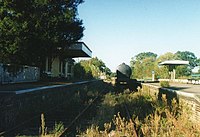
In 1989, a new company called the Great Eastern Railway (1989) Limited was formed to save the line, and the F&DRS signed the lease of County School Station over to the new company. The F&DRS, changed its name to become the Mid Norfolk Railway Society in 1990.[17]
The running line was extended over half a mile towards North Elmham, and a collection of rolling stock was built up. The first passenger train, a Mk2 brake coach converted to work as a DBSO with an industrial diesel locomotive, operated at the County School site on 2 November 1991.[18]
In 1991 the managing director of the GER (1989) Ltd., Trevor Cleaver, stated that he had raised much of the required finance and that the company intended to provide a regular passenger train service over the line by 1993. About 400 commuters a day were expected to use the service. Plans were also announced for special excursions such as shopping trips to London and summer seaside services. The plans included providing a hotel and conference centre at Dereham, along with a public house and shopping arcade.[19]
However, during the early 1990s the company changed direction and announced plans to lift the railway between Dereham and Wymondham. In 1995 finance failed, the receivers were called in and the company began asset-stripping.
The Society made their own bid for the line.[20][21] and in 1994 the British Railways Property Board granted the Society access to the railway line between Wymondham and North Elmham on a temporary 'care and maintenance' basis.
The Mid-Norfolk Railway Preservation Trust

The Mid-Norfolk Railway Preservation Trust was established in 1995 to buy and restore the disused line between North Elmham and Wymondham.[22] It was formed through the merger of the campaign groups and organisations that had been trying to restore passenger services over the route since 1974. The aims of the charity are "to preserve and to renovate reconstruct and operate for the benefit of the people of the County of Norfolk and of the nation at large, whatever of the historical, architectural and constructional heritage that may exist of the permanent way, track, buildings (including any building as defined in Section 336(1) of the Town and Country Planning Act 1990), bridges, operating equipment and rolling stock once forming part of or connected with or adjacent to the Great Eastern Railway line running between County School at North Elmham in the County of Norfolk and Wymondham in the County of Norfolk."[23]
In 1995 the section between Yaxham station and a temporary halt built beside a footpath crossing on the Rash's Green industrial estate in Dereham was inspected and permission to operate passenger trains over this section was granted. 63 trains, each composed of the five Mk2 coaches topped and tailed by the Class 20s, were operated between this date and 14 January 1996.[24]
On 11 April 1998 the sale of the route between Wymondham and Dereham to the Mid-Norfolk Railway Preservation Trust was completed, with the £100,000 purchase price including Dereham station buildings and the 6.5 acres of goods yard area. In a related deal the British Rail Property Board also accepted an offer of £25,000 for the 4½ miles between Dereham and North Elmham.[25]
The original Dereham station re-opened to passengers on Saturday 26 July 1997, with the first services being operated by 1890-built Manning Wardle 0-6-0T 'Sir Berkeley', hired from the Keighley and Worth Valley Railway.[26] The first preservation-era train to operate between Dereham and Wymondham ran on 8 February 1998, when a works train hauled by 20069 and Ruston & Hornsby 0-4-0 'County School ran as part of preparations for a March freight test train.[27] The first commercial freight train operated on 8 July 1998.[28]
Passenger services between Dereham and Wymondham commenced in 1999,[29] with the opening of Wymondham Abbey railway station.
Part of the line from County School to Wroxham is now the narrow gauge Bure Valley Railway.[30] The formation between Wells and Walsingham now hosts the miniature Wells and Walsingham Light Railway.[31] Both schemes are independent of the MNR. Another independent scheme, the "Norfolk Orbital Railway" plans to link the Mid-Norfolk Railway to the North Norfolk Railway and the coast at Sheringham.[32] In 2009 the Whitwell & Reepham Preservation Society announced an eventual intention to link up with either the North Norfolk Railway or Mid-Norfolk Railway.[33]
Present day

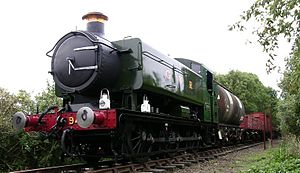
The 11½ mile section of line between Dereham and Wymondham is in regular use, with a further 2½ miles passed for operation, but only used for periodic charter and works trains. The Trust owns the further 3½ miles of disused railway to County School station near North Elmham,[34] although there is a break of around a mile between North Elmham and County School where the track is no longer in situ. This makes the Mid-Norfolk Railway one of the longest standard-gauge heritage railways in the United Kingdom. The track bed is mostly intact from County School to Fakenham, and is reserved by the council for railway use.[35] Although it is not yet in the Trust's ownership, the railway plans restoration of the line to this third market town.
The line features several preserved stations; Yaxham retaining period features such as the original signal box and shelters.[36] Trains run on most weekends from the end of February to December, and on Wednesdays and Thursdays in summer. There are special events throughout the year. The railway operates a dual traction policy, with equal value being given to trains being steam or diesel-operated.
The road vehicle loading ramp in Dereham Yard is frequently used by mainline train operators to load damaged rolling stock onto road vehicles. Such rolling stock usually comes at night (via the connection with the mainline at Wymondham) at slow speed (sometimes on wheelskates) from Crown Point depot in Norwich (where no road-rail loading facilities are available) for onward road movement to specialist repair facilities around the country.
The line has also been used to carry equipment for army units based at Robertson Barracks or undergoing training at the Stanford Battle Area. Operation of these trains involves both resident and mainline locomotives.[37]
Training and testing
The Mid-Norfolk Railway is also frequently used by mainline companies for crew training and the storage and testing of recommissioned and new on-track plant, including ballast tampers, ballast regulators, stoneblowers and Multi-Purpose Vehicles from companies including Network Rail and Balfour Beatty Rail Ltd. Since 2001 the line has been used annually for low adhesion training, or skidpan training, for crews: a specially fitted Class 153 treats the track with a slimy solution before the crew practices stopping in a virtual station.[38] The line has also been used for training exercises by East of England Ambulance Service, Norfolk Police and the Fire Brigade, including major incident training involving air ambulances.[39]
Television, film and theatre use
After passenger closure, County School station was used as the set for Weavers Green station in the Anglia Television soap opera of the same name. The same station, heavily disguised, featured as "Gare de Nouvion" (Nouvion railway station) in the penultimate episode[40][41] of 'Allo 'Allo!, the comedy series set in occupied France.
An episode of Off the Rails made for Discovery Channel in 2001 featured some to the activities and volunteers on the railway.[42]
In February 2004 County School stood in for Thetford station in a documentary about the arrival of American troops in Second World War, and in September 2005 the same location was used by Capriol Films for the film "Peter Warlock, Some Little Joy" about composer Philip Heseltine. [43] Dereham station, with the railway's British Rail Mark 2|Mark 2 coaches, featured in a minor film and the line has also appeared in documentaries for local and national television.[44]
In 2010, Michael Portillo visited the railway to film material for an episode in the second series of the BBC series Great British Railway Journeys. The filming used the Mid-Norfolk's green liveried 1957-built two carriage Class 101 Diesel Multiple Unit.[45]
In 2012 Dereham railway station was used as a stage for productions of the musical The Railway Children.[46]
Route details
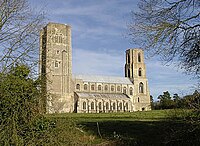
The Mid-Norfolk Railway Preservation Trust owned trackbed starts in the Wensum valley taking a roughly southerly direction. Track is missing between County School and North Elmham, but remains in situ from this point onwards and becomes operational from a point near the hamlet of Hoe. The line soon climbs out of the valley and enters the town of Dereham, passing two of the town's former maltings.
Leaving Dereham the route runs roughly southeast, passing over the River Tud, then descending to pass through the head of the Yare valley near the village of Thuxton. After passing Kimberley Park, the restored windmill[47] at Wicklewood can be seen to the west of the line, before the line drops into the Tiffey valley and most services terminate at a halt close to the Grade I listed Wymondham Abbey. Although not open to regular services, the line continues a further mile before joining with the main line at Wymondham railway station.
The route of the MNR includes the following stations, listed from north to south:
- Under restoration
| Location | Status | Opened | Closed | Notes | Photograph |
|---|---|---|---|---|---|
| County School | Visitor Centre | 1886 | 5 October 1964 | Restored to LNER World War Two condition with help from European funding, the station was presented as a museum memorial to the contribution of railways to modern warfare until it was repainted in a different colour scheme in 2010. The station has a car park, picnic area, toilets, and tea room. It serves as the focus for several footpaths in the Wensum Valley. The station's unspoilt isolation has seen it used as a film location on several occasions.
The station was presented with a Highly Commended certificate in the 1990 Ian Allan National Heritage Railway Awards. |
 |
| North Elmham | Closed / Private | 20 March 1849 | 5 October 1964 | Building and platform are in private ownership.
Plans exist to relay the track and build a new platform to enable the restoration of passenger services. The current layout in the station and south of the level crossing will need to be removed and relaid as straight track, these changes will happen as funds and volunteer labour allow. |
 |
- Operational
| Location | Status | Opened | Closed | Notes | Photograph |
|---|---|---|---|---|---|
| Dereham | Open | 15 February 1847 | 6 October 1969 | The headquarters of the railway, and has been restored to 1950s condition with help from European and Government funding.[48] The station[49] has a large car park, and is situated close to the town centre.
The line continues northwards to North Elmham, but is very rarely in passenger use as no stations are open to passengers yet on this section of the railway. The lack of signalling systems in Dereham also restricts use of the line northwards until this is installed and commissioned. |
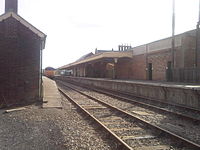 |
| Yaxham | Open | 15 February 1847 | 6 October 1969 | The station retains many of its buildings, including the signal box, in private ownership.[50] It is also the home of the Yaxham Light Railway[51] and a local boiler engineering company. | 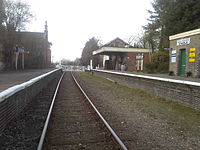 |
| Thuxton | Open | 15 February 1847 | 6 October 1969 | Thuxton's waiting rooms are, as with all the intermediate stations, private. The waiting room has been restored as holiday accommodation.[52]
Work to complete a passing loop at this site, provide operational signalling and lengthen the up platform to accommodate longer and more frequent train services was completed in 2010. The signalling is currently operated from a Lever frame in a temporary shed next to the level crossing, this arrangement will continue until the new signal box is completed and commissioned. The foundations of the waiting room on the up platform were left in place and the waiting room is currently being reconstructed and will mirror the waiting room on the down platform in private ownership. |
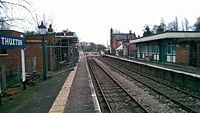 |
| Hardingham | Closed / Private | 15 February 1847 | 6 October 1969 | Hardingham station is restored and is passed between Thuxton and Kimberley Park. However this station, apart from the platforms, is private and no scheduled trains stop there. There are no public rights of way from nearby roads to any part of the station. In 2001 the station was awarded the Ian Allan Heritage Award.
The station yard, also in private ownership and not connected to the main line, is equipped with two maintenance sheds. A variety of mainline and industrial rolling stock is maintained on site.[53] In recent years public trains have stopped specially at Hardingham on one day only to transport visitors to Hardingham Fete.[54] |
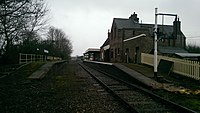 |
| Kimberley Park | Open | 15 February 1847 | 6 October 1969 | The station building is a private home, but the down platform has been restored for passenger use. |  |
| Wymondham Abbey | Open | 2 May 1999 | The station is a basic platform built using scaffolding and boards close to Wymondham Abbey. MNR trains do not serve the main Wymondham railway station. |  |
There have been plans to create additional stations at Hoe, Garvestone and Wymondham Junction railway station on the boundary between MNR and NR, allowing a short walk from branch to main line.
Outside links
| ("Wikimedia Commons" has material about Mid-Norfolk Railway) |
References
- ↑ Mid Norfolk runs first passenger train north to Hoe
- ↑ Oppitz, Leslie (Autumn 1989). East Anglia Railways Remembered. Countryside Books. p. 41. ISBN 1-85306-040-2.
- ↑ Scrivenor, Harry (1849). The Railways of the United Kingdom Statistically Considered. Smith, Elder and Co.. p. 334. http://books.google.com/?id=6jmFq73U91gC&pg=PA341&lpg=PA341&dq=norfolk+railway+act+of+parliament.
- ↑ MNR history of the line
- ↑ Jenkins, S. (1993). The Lynn and Dereham Railway. Oakwood Press. p. 50. ISBN 0-85361-443-1.
- ↑ Jenkins, S. (1993). The Lynn and Dereham Railway. Oakwood Press. p. 69. ISBN 0-85361-443-1.
- ↑ Jenkins, S. (1993). The Lynn and Dereham Railway. Oakwood Press. p. 87. ISBN 0-85361-443-1.
- ↑ British Railways Atlas.1947. p.18
- ↑ Joby, R.S. (1975). The East Norfolk Railway. Klofron, Norwich. p. 43.
- ↑ Tuddenham, E. (March 1965). Railway World. Ian Allan. p. 87.
- ↑ Cooke (ed.), B. (March 1968). Railway Magazine. T&TP Ltd. p. 662.
- ↑ "Kings Lynn branches last day". Railway Magazine: 662. November 1968.
- ↑ "Norfolk By Rail - 1980s News Archive". http://web.ukonline.co.uk/Members/rj.cullen/80.htm.
- ↑ "Railway Magazine". Railway Magazine: 38. 1977.
- ↑ "Photo Album : Historical Interest". Mid-Norfolk Railway Preservation Trust website. http://www.mnr.org.uk/photos/historical/.
- ↑ Chris, Leigh (March 1994). "Back to School with the GER". Steam Railway (167): 38.
- ↑ "A new name for the Society". Blastpipe (31): 4. Autumn 1990.
- ↑ "Notes and News: We are officially open". Blastpipe (35): 4. Autumn 1991.
- ↑ Hardy, Sarah (1 November 1991). "All aboard at County School". Eastern Daily Press, Out & About: 2–3.
- ↑ "Row hots up over control of rail line". Eastern Daily Press. 17 June 1994.
- ↑ "Battle for control of disused rail line comes to head". Eastern Daily Press. 1 February 1995.
- ↑ "Mid-Norfolk Railway Preservation Trust - History". Mid-Norfolk Railway Preservation Trust website. http://www.mnr.org.uk/about/.
- ↑ {{{2}}} - Registered Charity no. 1046931 at the Charity Commission
- ↑ "The First Trains Run". Blastpipe (50): 4. Spring 1996.
- ↑ "Mid-Norfolk line sold for £100,000". Rail Magazine: 11. 6 May 1998.
- ↑ "Back to School with the GER". Steam Railway (209): 21. September 1997.
- ↑ "Crowd greets first train back into Wymondham". Steam Railway (216): 16. April 1998.
- ↑ Traction '98 Pt 2 (video). Locomaster Profiles. 1998. http://www.locomaster.co.uk/traction_98_part_2.htm.
- ↑ "Mid-Norfolk Railway - History of the Line". http://www.mnr.org.uk/about/history/. Retrieved 4 May 2009.
- ↑ "Bure Valley Railway". Bure Valley Railway website. http://www.bvrw.co.uk/.
- ↑ "The Wells & Walsingham light railway". www.wellswalsinghamrailway.co.uk. http://www.wellswalsinghamrailway.co.uk/.
- ↑ "Norfolk Orbital railway : Closing the circle". http://www.norfolk-orbital-railway.co.uk. http://www.norfolk-orbital-railway.co.uk/pages/project.
- ↑ Nick, Brodrick; Hopkins, Danny (6 February – 5 March 2009). "Whitwell & Reepham revival". Steam Railway (359): 38.
- ↑ "From Jazz to Santa" (pdf). Dereham Times. http://www.derehamtimes.co.uk/content/derehamtimes/everything/EVE.pdf. Retrieved 2009-07-20. "The Trust currently owns 17.5 miles of track and trackbed, just over 11 miles of which is currently in use connecting Dereham Station with Wymondham Abbey Station"
- ↑ "Safeguarding Transport Routes" (pdf). Norfolk County Council. pp. 9. http://www.norfolk.gov.uk/consumption/groups/public/documents/article/ncc037183.pdf. Retrieved 18 February 2009.
- ↑ "Yaxham Station and its railways". Yaxham Light Railway website. http://www.yaxham-light-railway.fsnet.co.uk/About_Yaxham_Station/about_yaxham_station.html.
- ↑ "Mid-Norfolk Railway freight traffic". Fotopic.net. http://kl47576sgallery.fotopic.net/c1635157.html. Retrieved 10 May 2009.
- ↑ "Early October: Leaf Fall Training (2004)". Mid-Norfolk Railway website. http://www.mnr.org.uk/news/2004/october.html. Retrieved 10 May 2009.
- ↑ "Emergency services put to the test at ‘train crash’". Wymondham and Attleborough Mercury. http://www.wymondhamandattleboroughmercury.co.uk/news/emergency_services_put_to_the_test_at_train_crash_1_2167286. Retrieved 2013-05-07.
- ↑ "'Allo 'Allo episode guide". Cafe Rene: An 'Allo 'Allo Web Site. http://www.marktv.org/aa/series6-9.html#9.5. Retrieved 2009-03-28.
- ↑ BBC (1998). "'Allo 'Allo "Sand Trap"". veoh.com. http://www.blinkx.com/video/allo-allo-sand-trap/SA_bRrb6L7GVQ7fyT0v-Ew. Retrieved 2009-03-28.
- ↑ "Off the Rails". Discovery Channel. https://www.youtube.com/watch?v=NRKf7TuSdV4. Retrieved 4 April 2014.
- ↑ "MNR News Archive, September 2005". Mid-Norfolk Railway Preservation Trust website. 2005. http://www.mnr.org.uk/news/2005/september.html. Retrieved 2009-03-28.
- ↑ BBC (2008). ""Beeching's Tracks" Norfolk (2008)". IMDb. http://www.imdb.com/title/tt1323085/. Retrieved 2009-03-28.
- ↑ Knights, Emma (July 2010). "Portillo explores Norfolk rail heritage". Eastern Daily Press. Archant. http://www.edp24.co.uk/content/edp24/news/story.aspx?brand=EDPOnline&category=News&tBrand=EDPOnline&tCategory=xDefault&itemid=NOED19+Jul+2010+08%3A37%3A47%3A170. Retrieved 2010-07-28.
- ↑ Dereham Railway Station on track to host Railway Children musical
- ↑ "Wicklewood High Street towermill". Norfolk Windmills Trust website. http://www.norfolkmills.co.uk/Windmills/wicklewood-high-st-towermill.html. Retrieved 2009-04-22.
- ↑ "Old station reopens". Dereham Times. http://www.derehamtimes.co.uk/content/derehamtimes/news/story.aspx?brand=DFTOnline&category=News&tBrand=DFTonline&tCategory=news&itemid=NOED31%20Oct%202007%2014%3A41%3A41%3A090. Retrieved 2009-07-20.
- ↑ "photographic image of station". good-times.webshots.com. http://good-times.webshots.com/photo/2425432890093640653qsFklS?vhost=good-times. Retrieved 2009-07-10.
- ↑ "photographic image of Yaxham station". good-times.webshots.com. http://good-times.webshots.com/photo/2246872530093640653sKUJLj?vhost=good-times. Retrieved 2009-07-10.
- ↑ "Yaxham Station and its railways". yaxham-light-railway.fsnet.co.uk. http://www.yaxham-light-railway.fsnet.co.uk/About_Yaxham_Station/about_yaxham_station.html. Retrieved 2009-07-10.
- ↑ "Thuxton Station Waiting Rooms (property description)". aboutbritain.com. http://www.aboutbritain.com/self-catering-holiday-cottages/property4383.asp.
- ↑ "Great Eastern Traction". Great Eastern Traction. http://www.greateasterntraction.co.uk. Retrieved 2009-07-20.
- ↑ http://www.bedsparishes.gov.uk/fete/fete-trains-from-dereham-and-w/ Train services to/from Hardingham Fete

